Offering online courses is a wonderful way for small businesses to increase their revenue and build a strong mentor-student relationship with their audience.
After putting time and effort into building a course that’ll teach your audience something valuable, it’s crucial that you effectively promote it to that audience so that they can register and start learning.
Email marketing is one of the most affordable and personalized ways to do this promotion.
In this article, we’ll teach you the five emails you need to send to prospective and current students of your online course.
- Online Course Welcome Emails
- Online Course Information Emails
- Online Course Promotions Emails
- Online Course Re-Engagement Emails
- Online Course Feedback Request Emails
- Conclusion
Online Course Welcome Emails
Whenever someone signs up for your online course, it’s important to immediately send them a warm welcome email thanking them for their registration and providing them with helpful resources and guidance.
For example, a welcome email might include the first few steps the student should take within the course platform. Maybe that’s creating a username and saying hello in the forums.
In Location Rebel’s course welcome email, the founder gives new students some action items:
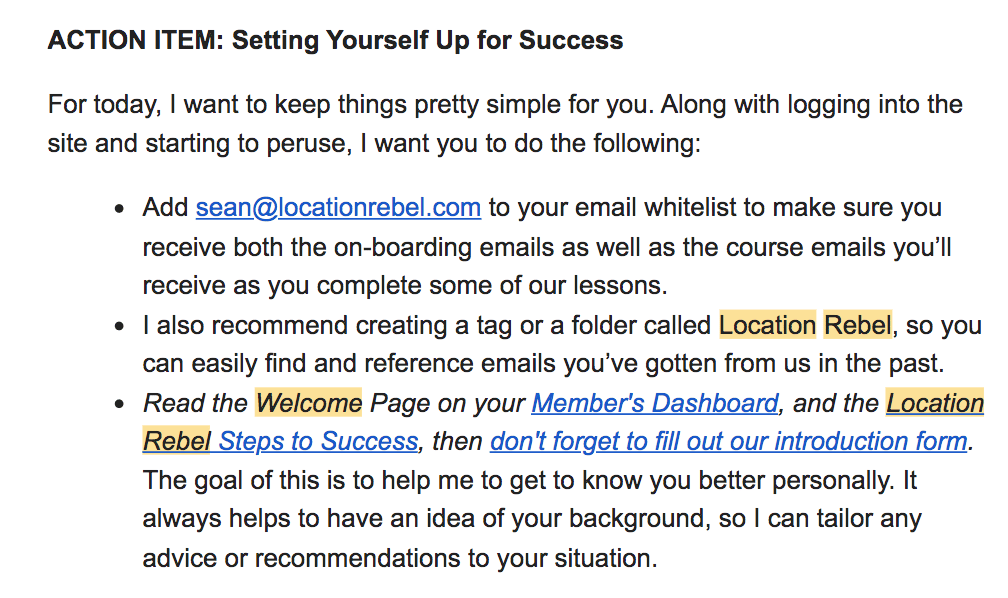
Source: Location Rebel
This gives users some direction and eliminates any new-student paralysis caused by confusion or information overload.
Additionally, your email should aim to introduce the buyer to your brand and briefly describe the course they’ve just purchased.
This ensures that people who might’ve made a purchase on impulse know exactly what they’ve signed up for.
They get a clear summary of what they’ll learn, how long the course takes, and what actions they’ll have to take over the next few weeks.
Reinforcing the value of the course after they’ve purchased it will also increase the chances they take the course in its entirety instead of just putting it on their future to-do list.
But these welcome emails should be used for more than just thanking and informing the recipient. They’re too valuable for that: they boast high open rates.
Research shows that the average open rate for welcome emails is 50%-86% greater than the open rate for email newsletters.
People are excited to start learning, and they’re happy to receive any useful advice from the course creator, their teacher.
Take advantage of this high open rate and use the email to promote other offerings, such as some other courses they might be interested in.
For instance, a brand selling a course on Indian cuisine might include a link to a complementary course on Indian spices with a related image.
They might even include a discount to nudge the student to make the purchase.
You could also use this welcome email to encourage your students to fill out a survey, the results of which can help you improve your marketing strategy.
Income School, a blogging course creator, uses this approach in their welcome email, shown below:
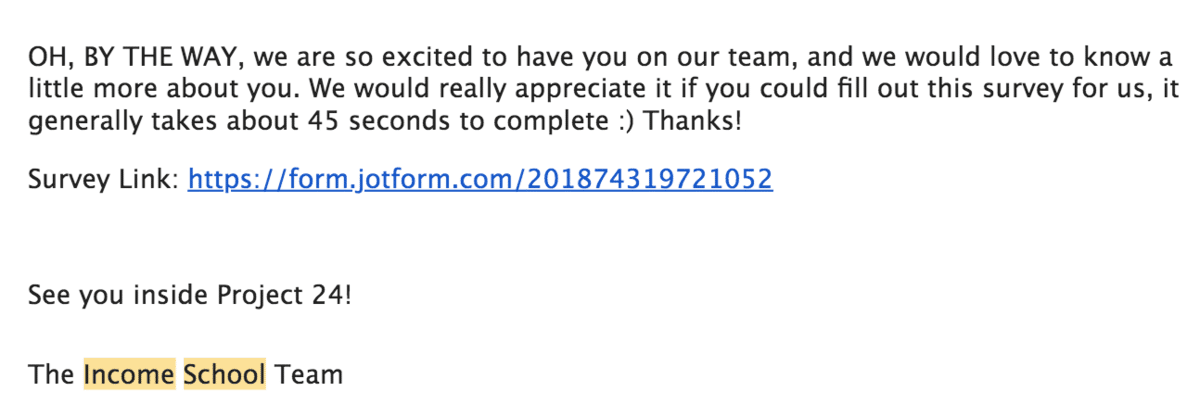
Source: Income School
Note the inviting tone they use to welcome their students.
They use phrasing like “we are excited to have you on our team”, thereby making the student feel like they’re part of a community, even if all their interactions with students, content, and teachers take place online.
To sum up, welcome emails for online courses serve to build your connection with the student, provide useful information, and also encourage them to take the next steps that will help your business.

Your Courses Matter, So Does Your Cash Flow
See How Efficient Registration Affects Cash Flow!
Online Course Information Emails
You should always keep a separation between your business’s informational and marketing emails so students don’t begin to think of you as a brand with aggressive sales tactics.
Information emails should provide students with free, valuable information about the online course and tangential subjects or materials.
Supplying free news, updates, and brand content will keep your students engaged and excited about the course and prevent them from forgetting about it.
The emails also paint you as an expert in the industry who is committed to teaching your students.
For example, an English History online course might send an email announcing the publication of a new history book on the topic that they feel students might like.
For this email to stay informational, though, it would have to recommend a book published by a person other than the online course company, so the brand has no financial ties to it.
They’re simply recommending it because it can help students expand their knowledge of the subject.
For another example, an online course company for wedding planning might send out a free downloadable checklist they recently designed to help students plan weddings.
Income School shares a weekly digest where they tell students what their team has been working on and share helpful podcast episodes and youtube videos that relate to topics taught in their blogging course:
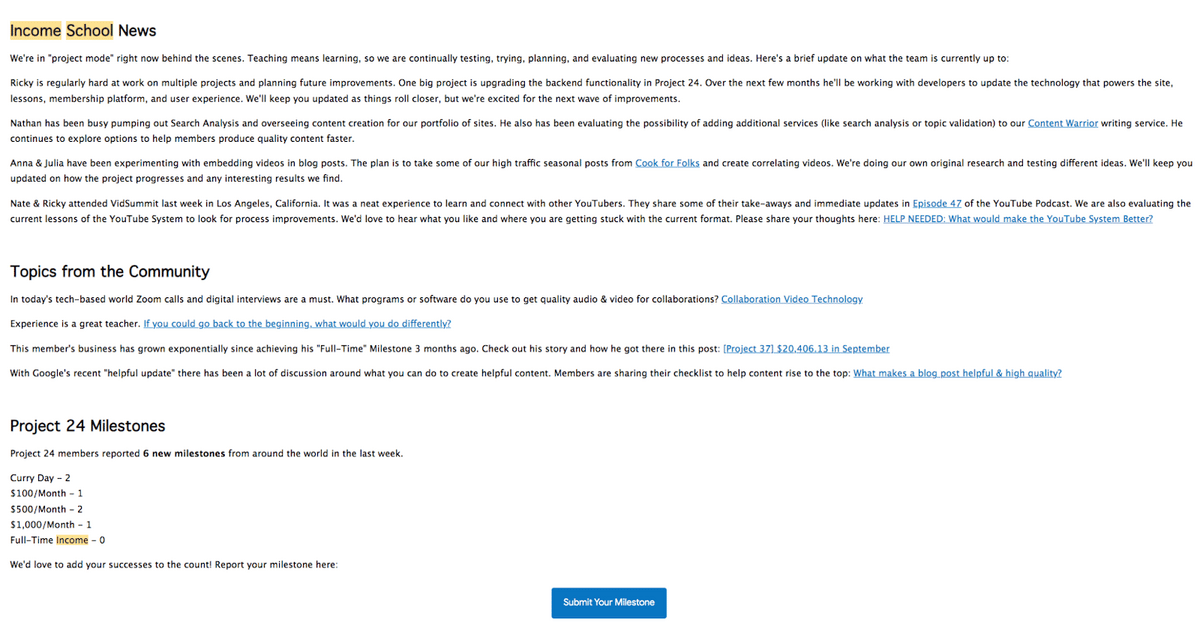
Source: Income School
They even update students on the number of other students who have reached a learning milestone. This tactic inspires and motivates students to keep using the course.
In addition to helpful content, online course providers can also share updates about their courses.
If you add new content, videos, or modules, it’s important to share this with the students so they don’t miss out.
Regularly sharing information with your students does a lot to make them feel like they’re part of an online school, not just purchasers of a one-off course.
Online Course Promotions Emails
Online course promotion emails are important to add to the email mix because they encourage students to sign up for more online courses.
If you sell multiple online courses, target your current students and try to get them to enroll in other ones similar to the courses they’re already taking.
This approach capitalizes on the fact that the recipients are already trusting of your brand and interested in the topics you teach.
In your emails, you can either cross-sell, e.g., by marketing some related courses, or upsell, by marketing the higher tier of the course they’re currently taking.
For example, a business might have customers in a free course that gives them only accessibility to materials, videos, and perhaps professional certificates.
To upsell their students, they might send them promotional emails highlighting the benefits of switching to the paid option.
Outlining the benefits of taking another course is only part of what goes into an effective promotion email.
You should also include a call-to-action that tells the customer exactly what to do.
That could be a linked button saying “watch the video on X course” or a sentence before a link telling them to “click the link below to check out the course”.
edX, an online course platform, uses a red CTA button that names the skill students will acquire if they take the course they’re marketing in their email:

Source: edX
Clear directions on what you want the customer to do are essential. Graphics and images of the course also help to get the student excited.
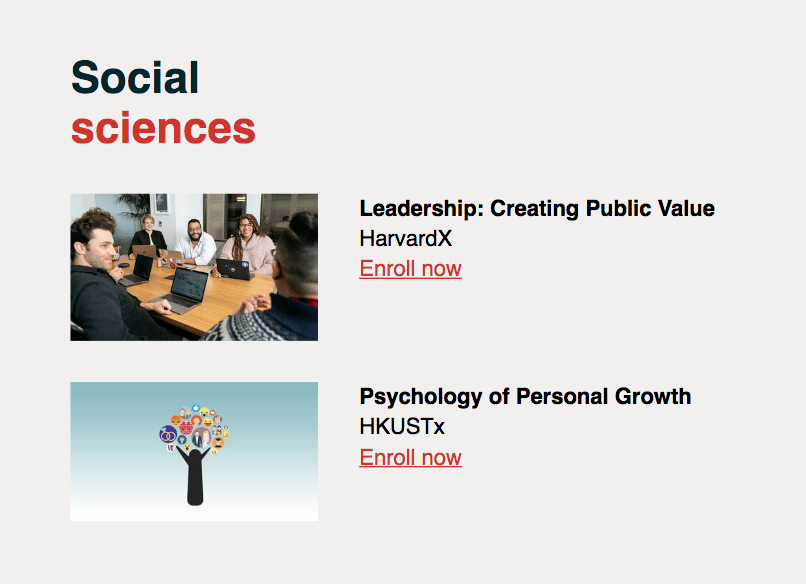
Source: edX
To increase the chances they sign up, you could also offer a limited-time discount on the course, or give them the option to buy one course and get another free.
Below, Sean Ogle emails current students about a limited-time offer for a new course his team has just created:
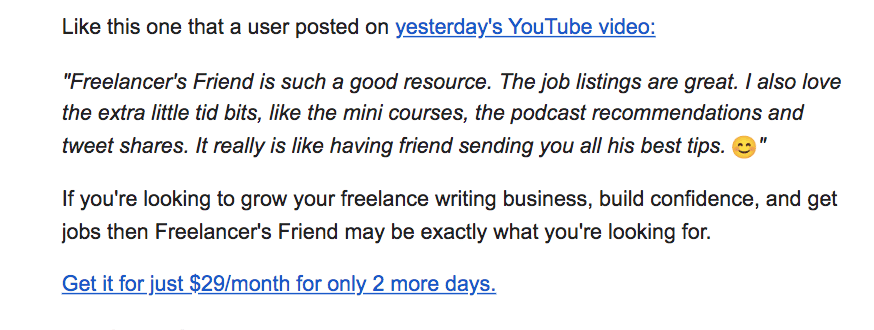
Source: Location Rebel
CopyHour, an email-based online course, does this as well:

Source: CopyHour
In sum, promoting your online courses to current students is a cost-effective way to deepen their relationships with your brand and increase sales for your small business.

Course Registration That Gets You Paid On Time, Every Time
Increase Your Cash Flow By 35%!
Online Course Re-Engagement Emails
It’s likely that some students might get busy and take breaks from the online course, but you don’t want them to ditch it altogether.
Sometimes, all they need is a friendly reminder about the value of the learning project they once felt was a priority in their life.
Send online course re-engagement emails out to your students who haven’t finished their courses or logged in for a couple of weeks.
Renew their interest in the course by highlighting the benefits of taking the course, especially the boosts they’ll receive to their career, life, skillset, or mind, once they’ve finished it.
A great way to do this is to chronicle a student success story about someone accomplishing something great with the skills they learned in the course.
For example, a company offering a creative writing course might compose a re-engagement email featuring a story about a student who successfully published a book after finishing the course.
They might also include a testimonial from that student to enhance the credibility of their claim about the causal connection between her success and her taking the course.
You could also write a few paragraphs that remind the student about why they originally signed up for your course.
To see this in action, check out Matt D’Avella’s email for his Master Email online course:
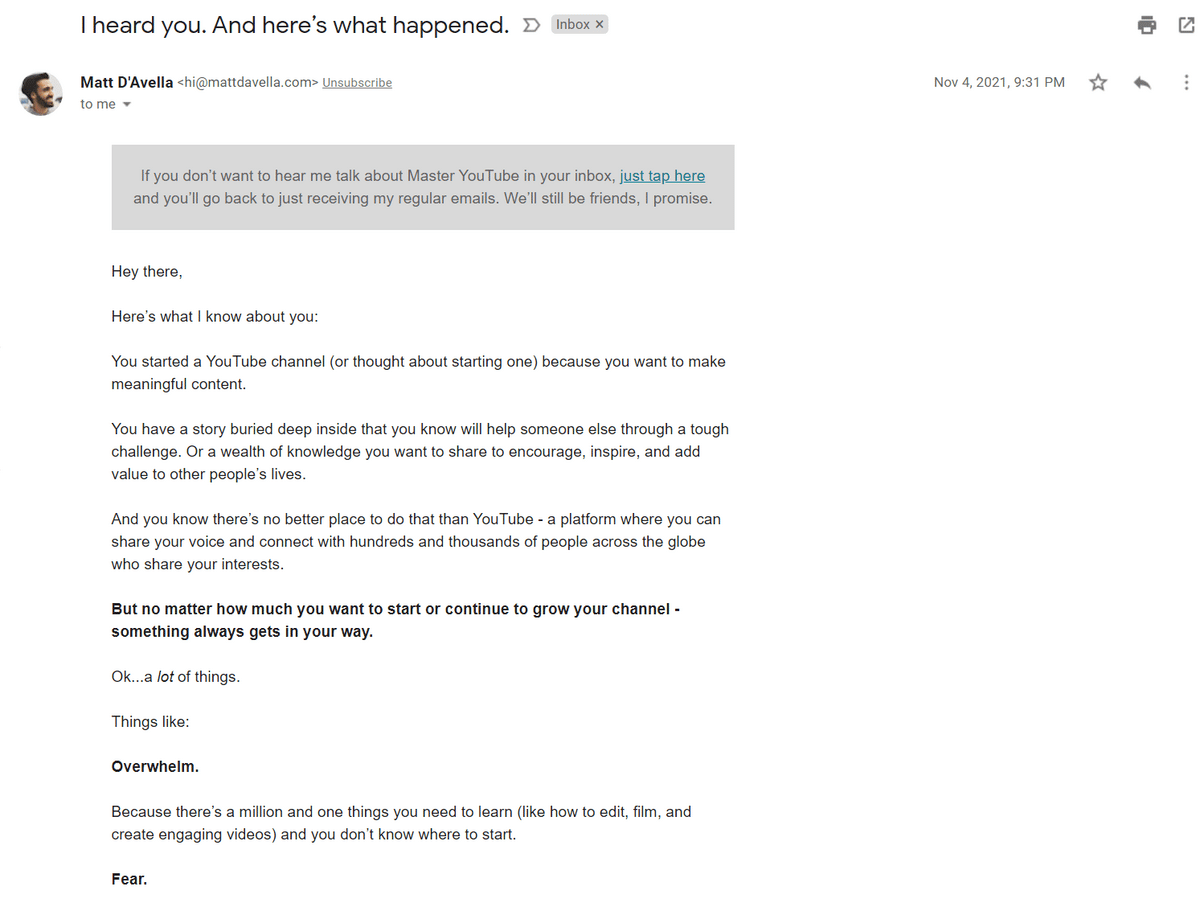
Source: MailPoet
To be considerate, he also gives his recipients the option to opt out of emails about this online course and just receive regular emails.
This technique makes the re-engagement email seem less forceful and aggressive.
Another use for re-engagement emails is to complete the sale to students who left a course in their cart but never finished the checkout process.
These are also called cart abandonment emails.
edX sends these often and uses a 10% discount to encourage students to finish the purchase:
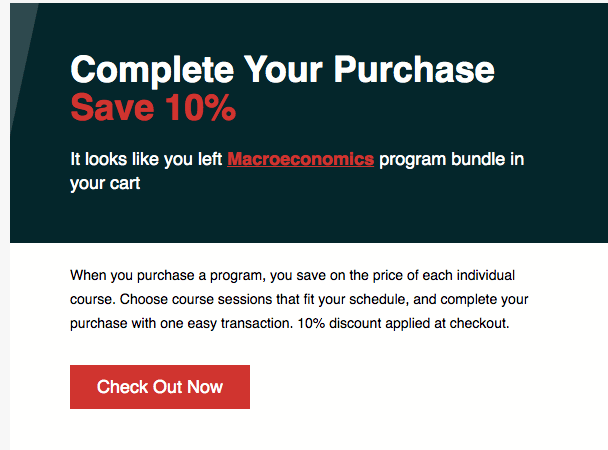
Source: edX
This email clearly states what course they intended to buy, offers a discount, and gives them the benefits of buying the course bundle instead of buying courses individually.
It’s your job to reignite the enthusiasm for your course material, and re-engagement emails, packed with success stories and course benefits, are a great way to do that.
Online Course Feedback Request Emails
Once a student finishes an online course, they should receive an email requesting feedback in the form of an online survey, which you can easily put together with a tool like SurveyMonkey:
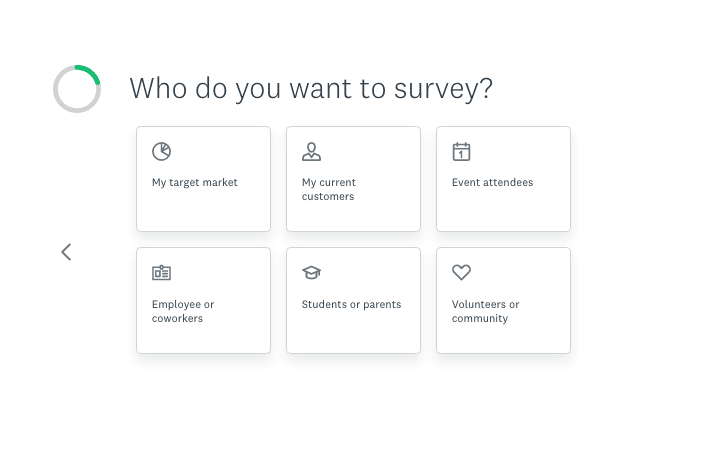
Source:SurveyMonkey
The reason for sending the email immediately after the student finishes is that people’s motivation to give feedback diminishes as time passes.
And so does their memory of the experience.
Someone angry about a taqueria forgetting their salsa in the takeout order might be fuming that evening but understanding the next day.
You want to capture the feedback when it’s most honest. Hopefully, honesty will mean great reviews for your course, which will help you promote your course to new customers.
But sometimes you’ll get more constructive, even negative, feedback.
Although this kind is less fun to receive, it will help you think of ways to enrich and improve your online course going forward.
As for the structure of a feedback request email, start by congratulating the recipient for achieving their goal. Next, politely ask them to review the course and make suggestions.
Usually, businesses include a link that recipients can click to enter into the online review form.
You could also create a CTA button, like in the email below:
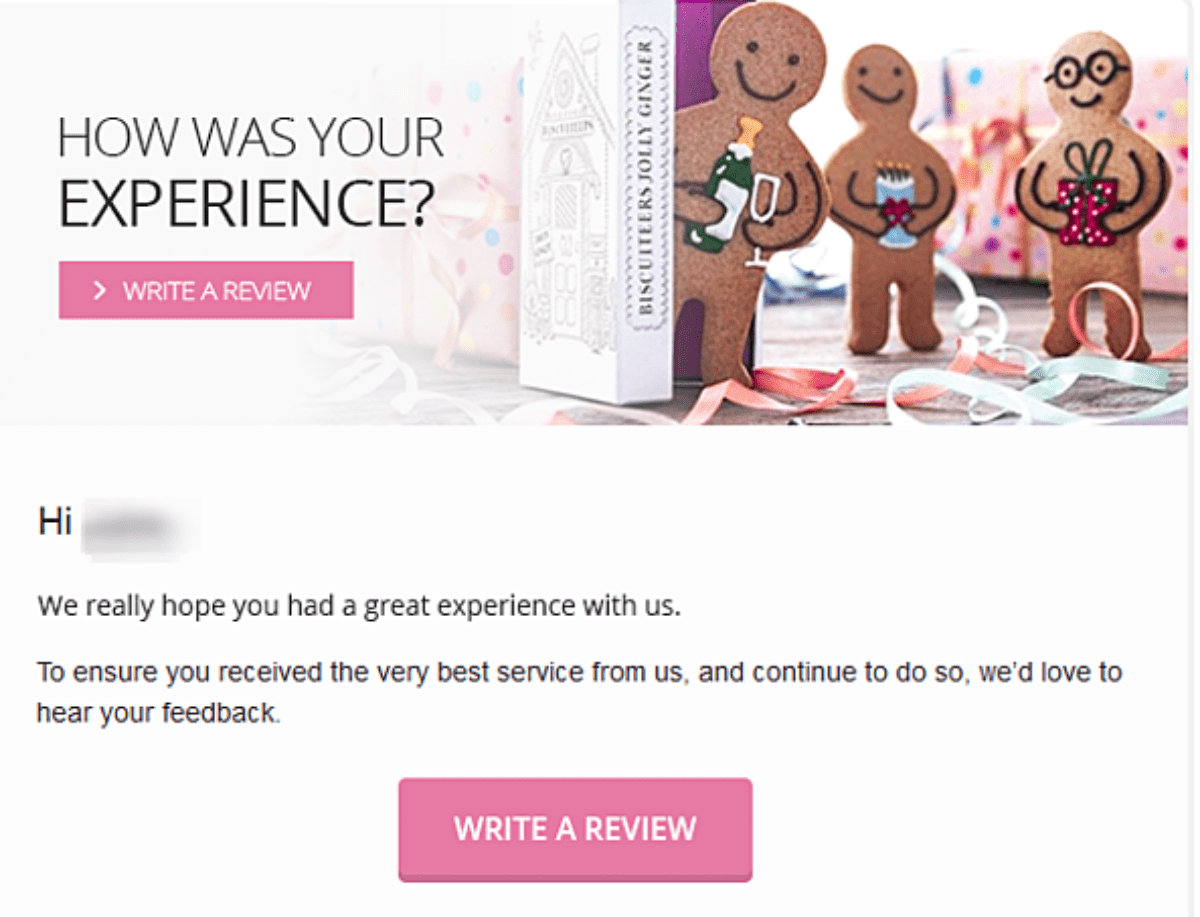
Source: SendPulse
Keep it personal, and be sure to explain that reviewing your business will help you improve your product.
This language makes them feel like you are always striving to better serve your customers, and it plays on their desire to help those who have helped them.
If you want to sweeten the deal, offer a discount to another of your online courses if they finish the survey. An added benefit of offering the reward is that you’ll sell more courses.
Although it’s not a course review email, Shopify offers a good example of encouraging reviews, as they enter their reviewers into a raffle:
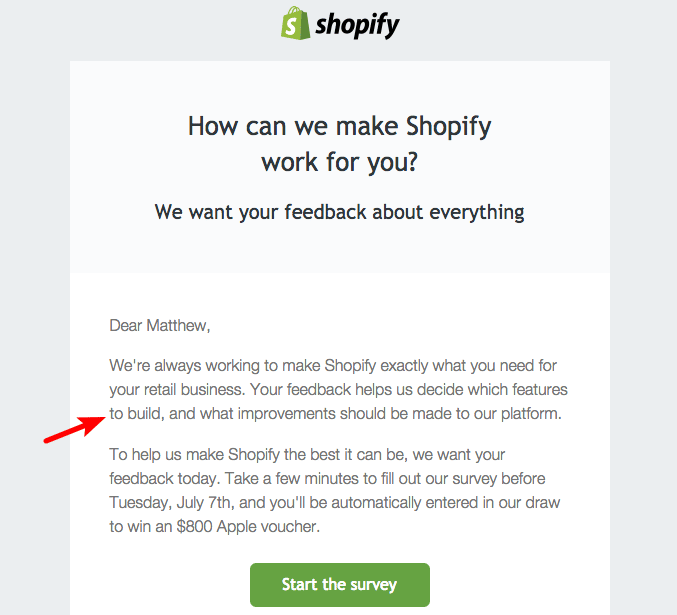
Source: HeroThemes
Feedback emails are your chance to gather customer testimonials for your course as well as insight into how you can make your course even better.
Conclusion
Communication with prospective and current buyers of your online courses is essential for increasing course sales and building lasting customer relationships.
To communicate effectively, online course sellers should send five types of emails: welcome emails, informational emails, promotional emails, re-engagement emails, and feedback requests.
Regardless of which email you’re creating, remember to personalize it to the customer.
Use their name, speak to their interests, and bring up their past experiences with your brand, like the courses they’ve already enjoyed.
This personal approach will make your relationship truly feel like that of a dedicated teacher and an inspired student.

Course Registration Shouldn’t Be Complex
Simplify Your Process, Raise Your Cash Flow!


















